
TL;DR - What is Conversation-Led Growth?
Conversation-Led Growth™ (CLG) is a trademarked framework by respond.io that helps businesses turn chats into measurable revenue across three stages:
Capture — Widen the funnel with chat entry points (chat widgets, chat links, click-to-chat ads, QR codes) and pull every conversation into a single inbox.
Convert — Use AI agents for FAQs, lead qualification, bookings and routing; hand off nuanced cases to human agents to close faster.
Retain — Drive repeat purchases with promotional broadcasts/newsletters and renewal reminders; deliver seamless, context-rich support to reduce churn.
Are you receiving high volumes of conversations from leads? Do you want to leverage these conversations to drive business growth? After years of helping over 10,000 brands turn conversations into tangible business outcomes, respond.io developed and trademarked the Conversation-Led Growth™ framework, designed to help businesses effectively implement a conversational growth strategy.
Here, we’ll dive into the importance of a conversational growth strategy and the common challenges businesses encounter when managing conversations. Finally, we’ll show you how the Conversation-Led Growth™ framework addresses them.
What is Conversation-Led Growth™?
Conversation-Led Growth™ (CLG) is a framework designed to help businesses maximize lead capture and sales chat conversions. It operates on the principle that every conversation is an opportunity for businesses to engage, delight and convert customers.
Whether it’s a chat initiated by a curious first-time visitor or a query from a long-standing customer, each conversation is a chance to grow your business.
Conversational Growth Strategy: Why do you need it?
Every conversation businesses have is a valuable opportunity for them to achieve tangible business results. Therefore, the more conversations you have, the more opportunities you’ll have to convert leads into customers and keep existing customers coming back for more.
However, many businesses hesitate to drive conversations as they lack cost-effective methods for managing conversations at scale. This is especially true if they rely on traditional communication channels.
How You’re Likely Managing Conversations and How You Should Manage Them Instead
Engaging with leads and customers through traditional channels like email and webchat demands significant manpower and fails to provide agents with the context they need to effectively assist customers.
For instance, emails often lead to extended response times and phone calls confine agents to managing one conversation at a time. Website chats can be interrupted when contacts leave the site or experience internet glitches, forcing them to restart conversations and repeat themselves.
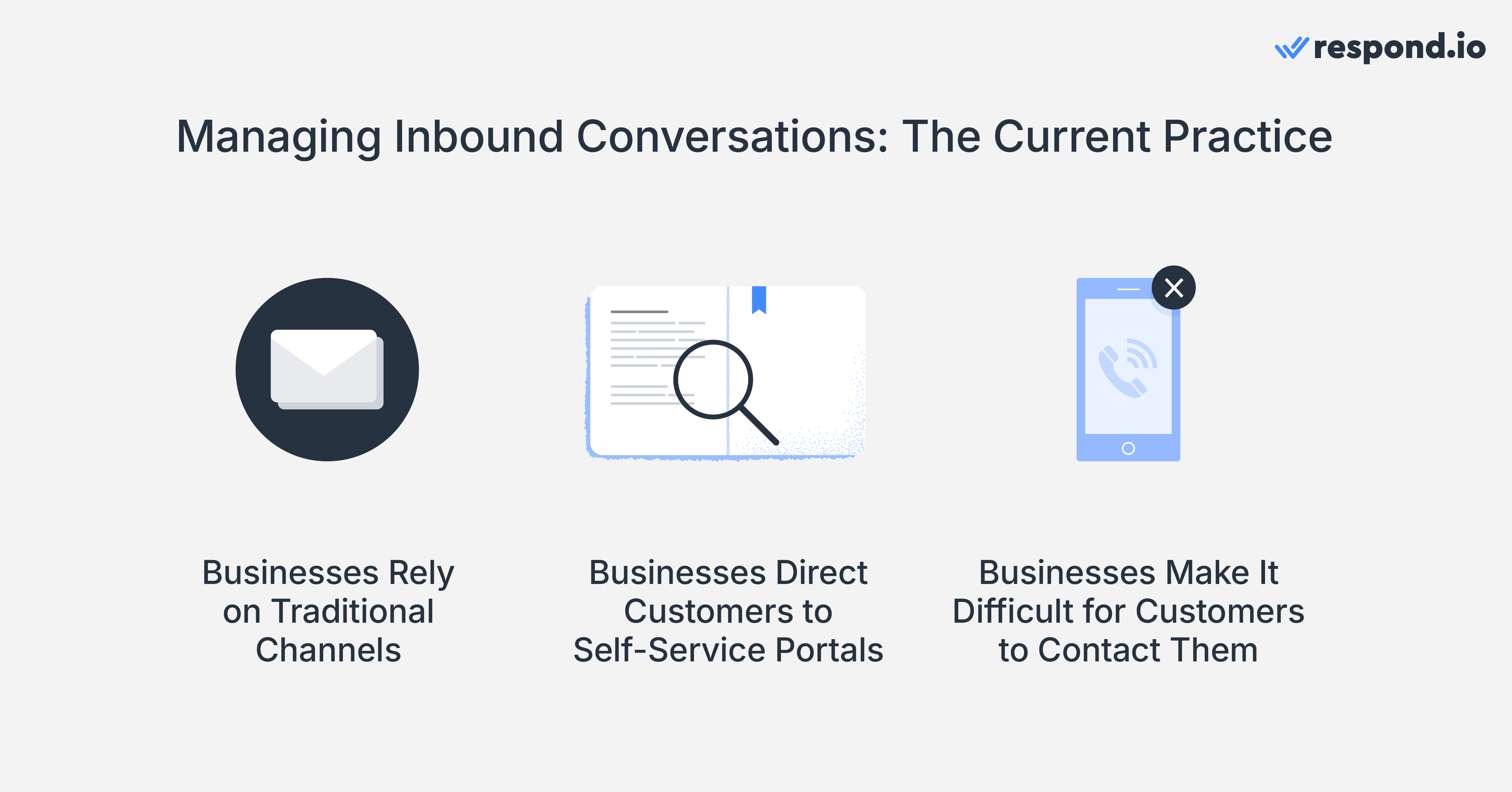
Due to these challenges, businesses often divert conversations to self-service resources like FAQ pages or help centers, assuming these resources are sufficient.
In more extreme cases, some businesses even discourage leads and customers from reaching out entirely by making it difficult for them to initiate contact or by not providing clear means for them to get in touch.
Businesses operate under the assumption that this approach is easier and more cost-effective. However, they overlook how each conversation provides opportunities for business growth by pushing leads further along the customer journey. Let’s see how conversations achieve this.
Leverage Conversations to Move Leads Along The Customer Journey
Every day, businesses unknowingly miss out on valuable opportunities that can lead to business growth. While it may seem like potential leads are actively engaging with your brand through likes and comments on social media posts, opportunities often go unnoticed.
The customer journey starts when potential leads discover your brand. During this stage, they typically seek information on your website. If they stumble upon a product they're interested in but can't find answers to questions related to it, they may stop exploring your products and services altogether.
As leads move towards making a purchase, online reviews greatly influence their decision. Positive reviews often lead to sales. However, obstacles like broken "Buy Now" links can cause missed opportunities and abandoned sales.
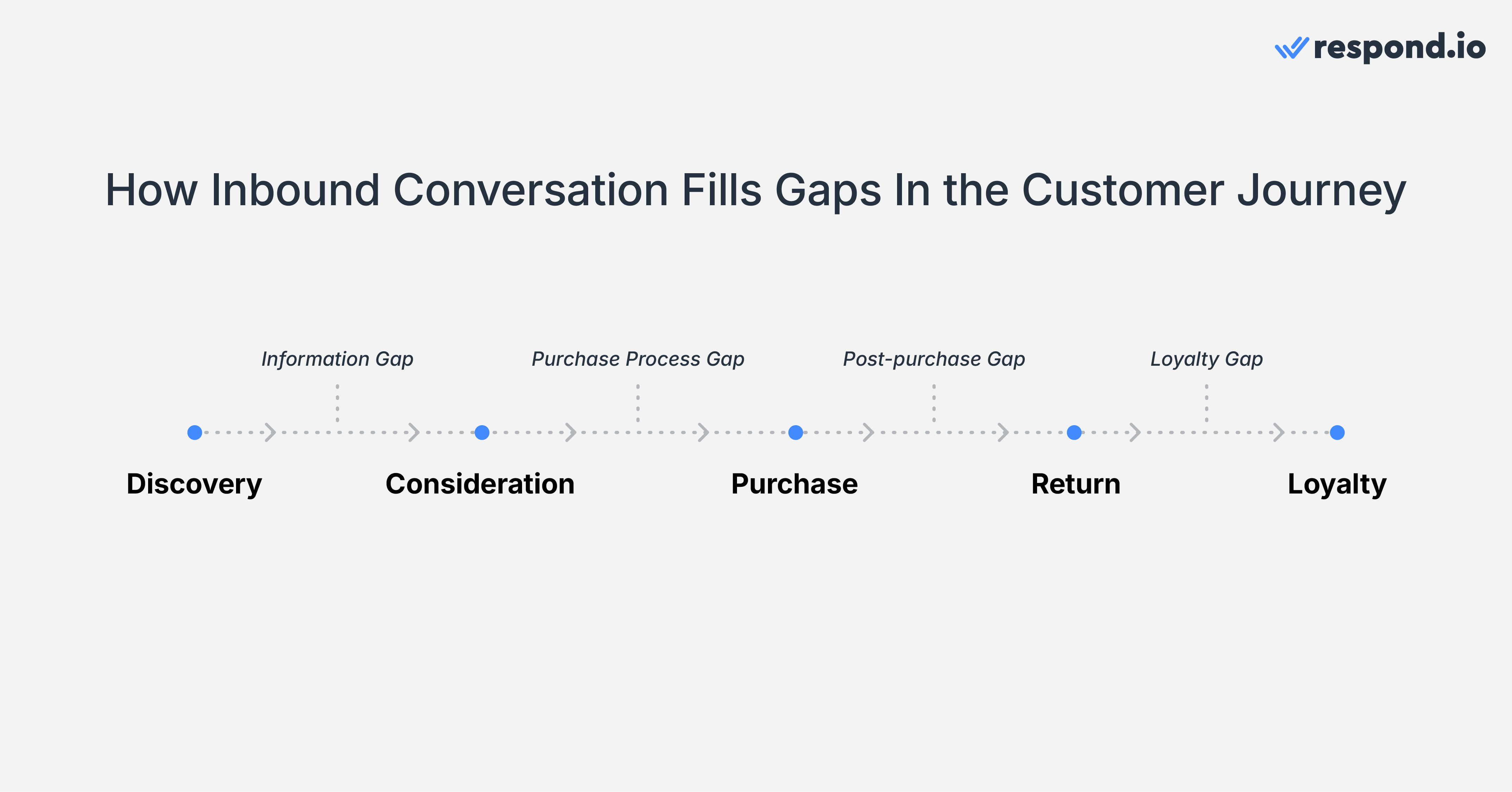
When issues arise post-purchase, like product defects or dissatisfaction, customers turn to you for assistance, whether it's to file a complaint, request a replacement or seek a refund.
If they cannot reach your business easily, face unanswered calls and emails or are directed to your FAQ page or help center, this subpar support can lead to customer dissatisfaction and harm your business's reputation.
As businesses want to turn customers into repeat buyers for a steady stream of income, it's important to recognize how initial experiences impact the likelihood of their return. If customers have a negative impression, they may disregard your brand or explore your competitors. This leads to loyalty challenges where you stand to lose customers.
In short, each failed attempt to get information, take action or contact you creates a gap in the customer journey. To successfully bridge these gaps, you need to make it easy for customers to chat with you and vice versa.
To begin, include instant messaging channels in your customer communication strategy if you haven't already.
Use Instant Messaging Channels to Drive Conversations
Starting a conversation on instant messaging channels like WhatsApp, Facebook, Instagram and TikTok is quick and straightforward. Leads can send messages anytime and receive faster replies compared to traditional communication channels like email or phone calls.
This real-time interaction aligns with modern expectations for immediate communication but poses challenges for businesses that are understaffed, receive high volumes of messages or have a presence on multiple instant messaging channels that need to be managed individually.
These scenarios can strain resources and slow down response times, affecting lead engagement and satisfaction.
Pros | Cons |
|---|---|
Combines structure and immediacy | Potential conversation overload |
Real-time responses | Expectation of immediate replies |
Convenient history access |
Instant messaging channels offer a valuable feature by providing a chat history, allowing both leads and agents to reference previous conversations for context. However, if a business operates across multiple messaging channels, maintaining a centralized history of customer interactions becomes challenging.
This centralized history is vital for ensuring a consistent experience across all channels as 90% of customers expect seamless interaction continuity across all contact channels. This is when a robust customer conversation management platform like respond.io and its conversation-led growth strategy comes into play.
Turn customer conversations into business growth with respond.io. ✨
Manage calls, chats and emails in one place!
Understanding the Respond.io Conversation-Led Growth™ Framework
The Conversation-Led Growth™ framework consists of 3 Stages: Capture, Convert and Retain, each created to achieve the CLG goal of maximizing lead capture and optimizing sales chat conversions.
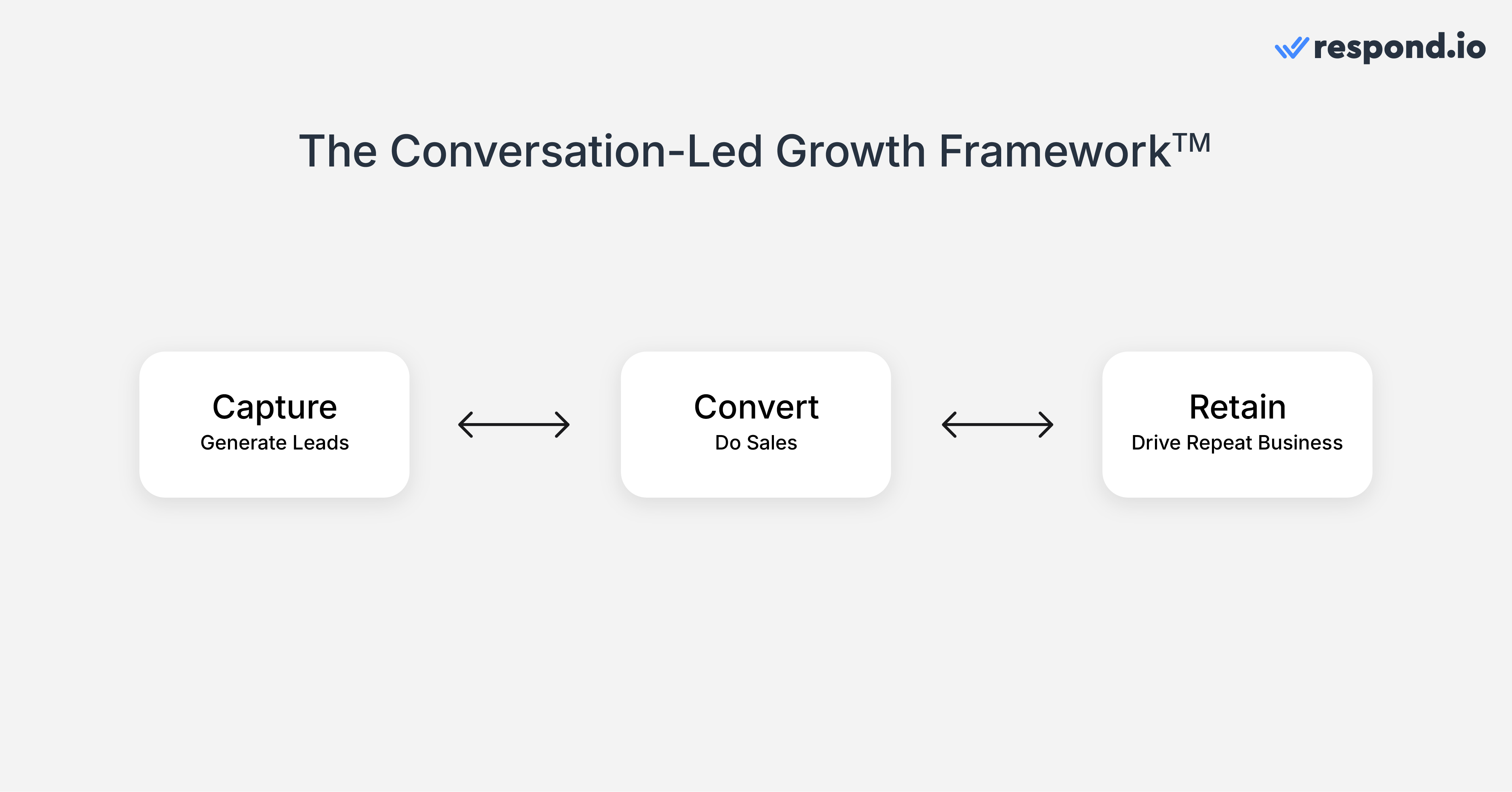
Note that these stages do not strictly follow a linear or cyclical progression, as they can be adapted to meet various business needs. Now, let’s take a closer look at each stage below.
Capture: The Digital Net for Business Opportunities
The first stage, Capture, is for businesses aiming to generate and collect leads by having conversations with them. This stage is all about widening the top of the funnel. You want to attract people who are hearing about your business for the first time.
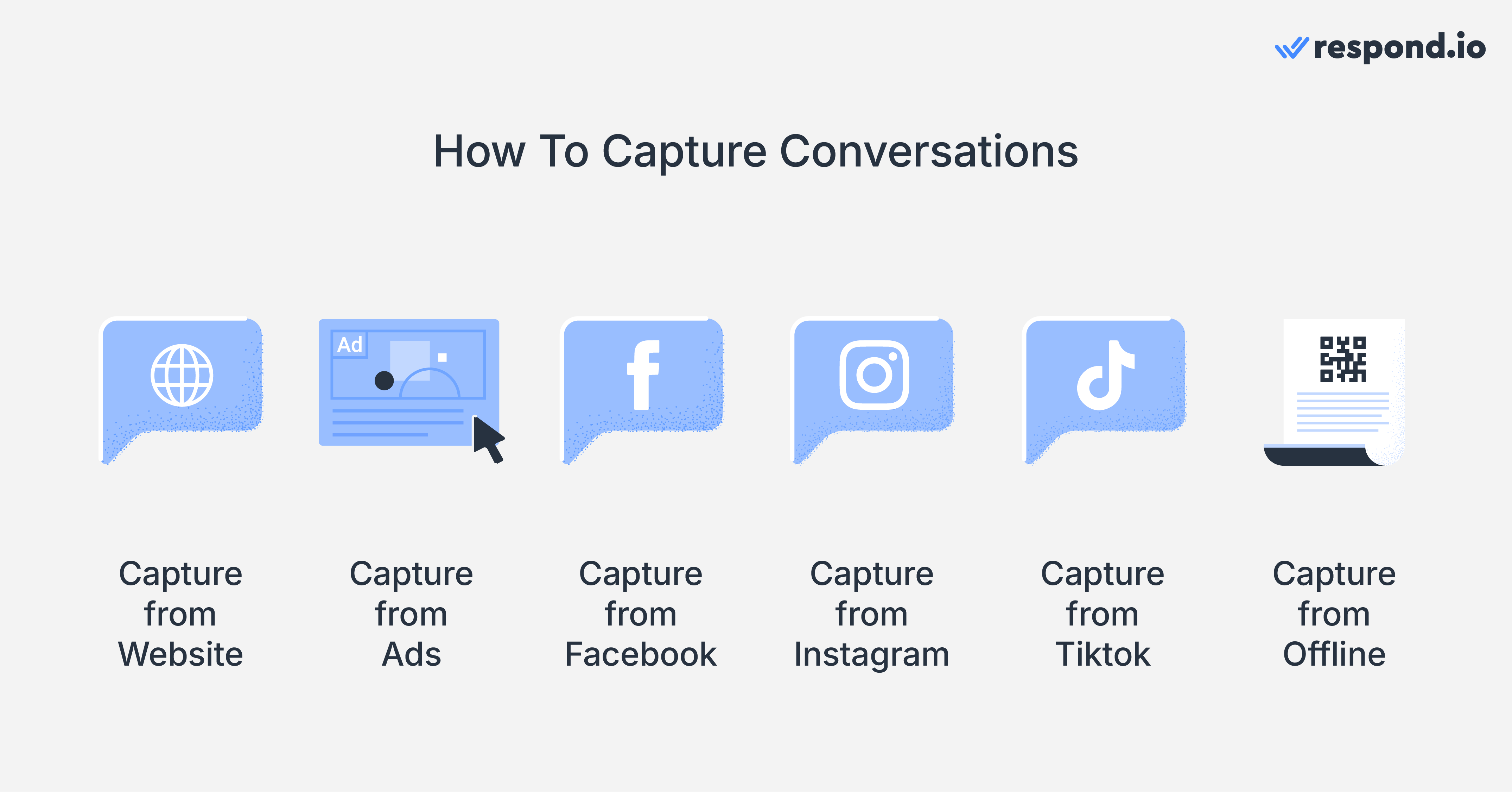
Strategies might include website widgets and chat links on your website, social media capture through click-to-chat ads on Facebook, Instagram or TikTok or even using QR codes strategically placed in brick-and-mortar stores.
The conversations you manage to "capture" here become the leads that enter the next stages of your cycle.
Convert: The Conversation Engine that Drives Sales
The next stage, Convert, is for businesses aiming to turn leads into paying customers efficiently. To convert leads faster through chat, you need to know when to use AI agents and automation, when to route conversations to human agents and how to handle these conversations skillfully.
Not all conversations require manpower to resolve satisfactorily or get the results you want. In fact, an AI agent can sometimes deliver better experiences or get better results.
For instance, you can let AI handle routine tasks like automatically qualifying leads, responding to FAQs, automating meeting bookings and routing conversations to sales agents.
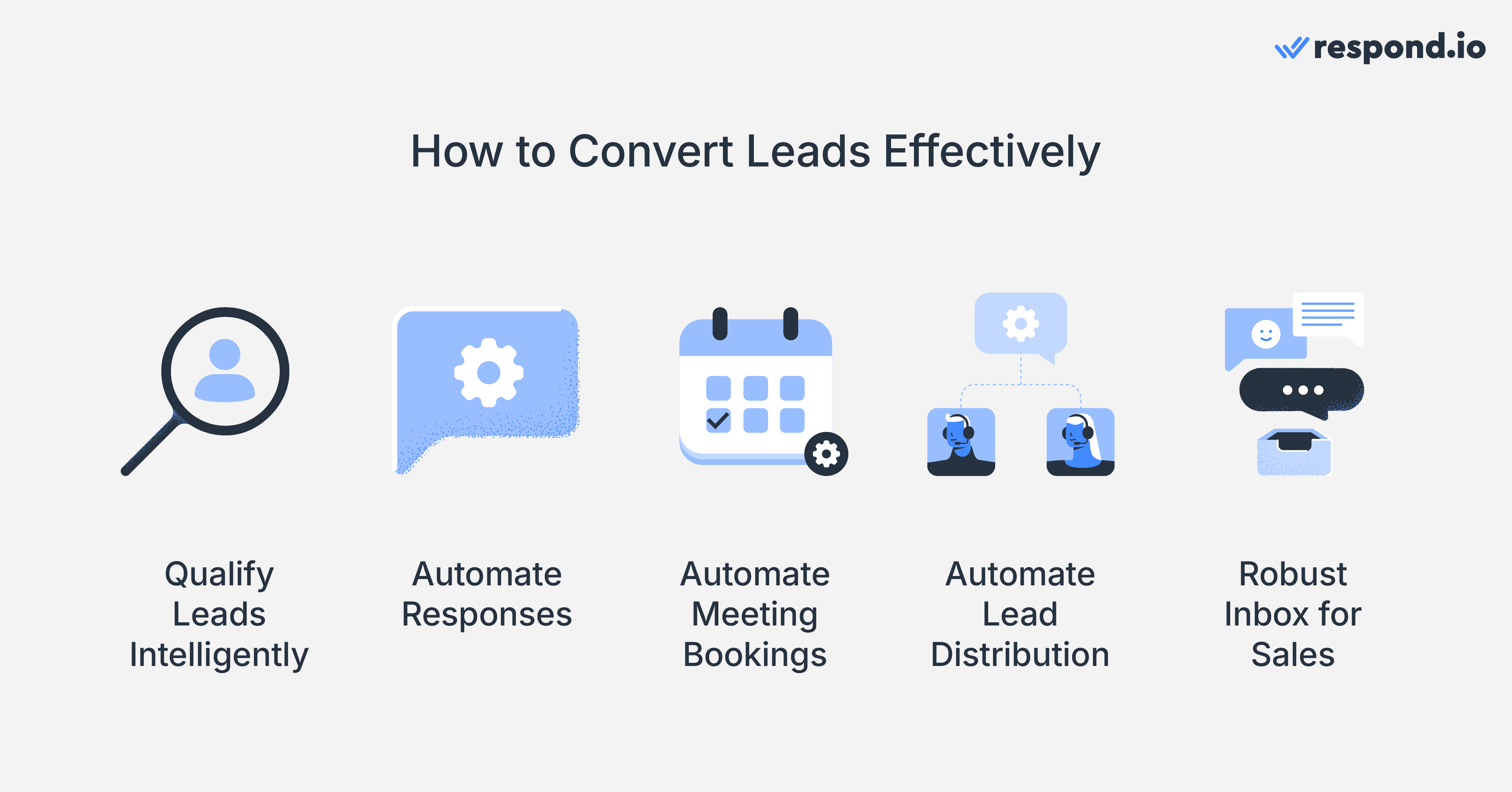
While sales agents usually manage multiple conversations at once, a robust sales inbox can help them do it efficiently. For instance, it can provide a complete view of customers, allowing sales agents to better understand their needs and provide tailored product recommendations.
In some cases, agents may need to talk to customers for a more human touch. The new WhatsApp Business Calling API enables businesses and customers to talk to each other through the WhatsApp API.
Additionally, advanced features like AI Assist empower agents to offer quick and accurate answers, enhancing the overall customer experience.
When in doubt, agents can leverage internal expertise within their teams through internal chats, escalate conversations when the issue is out of their expertise and more to ensure that leads receive the best possible service.
By implementing these strategies, businesses can push leads down the funnel faster and turn them into paying customers. However, converting leads is just one part of the equation. To ensure consistent revenue, businesses must also focus on turning these customers into repeat buyers.
Retain: Keep Customers Coming Back for More
The final stage, Retain, is crucial for businesses aiming to drive repeat business and maintain long-term customer relationships. The goal here is simply to keep customers coming back for your product or service.
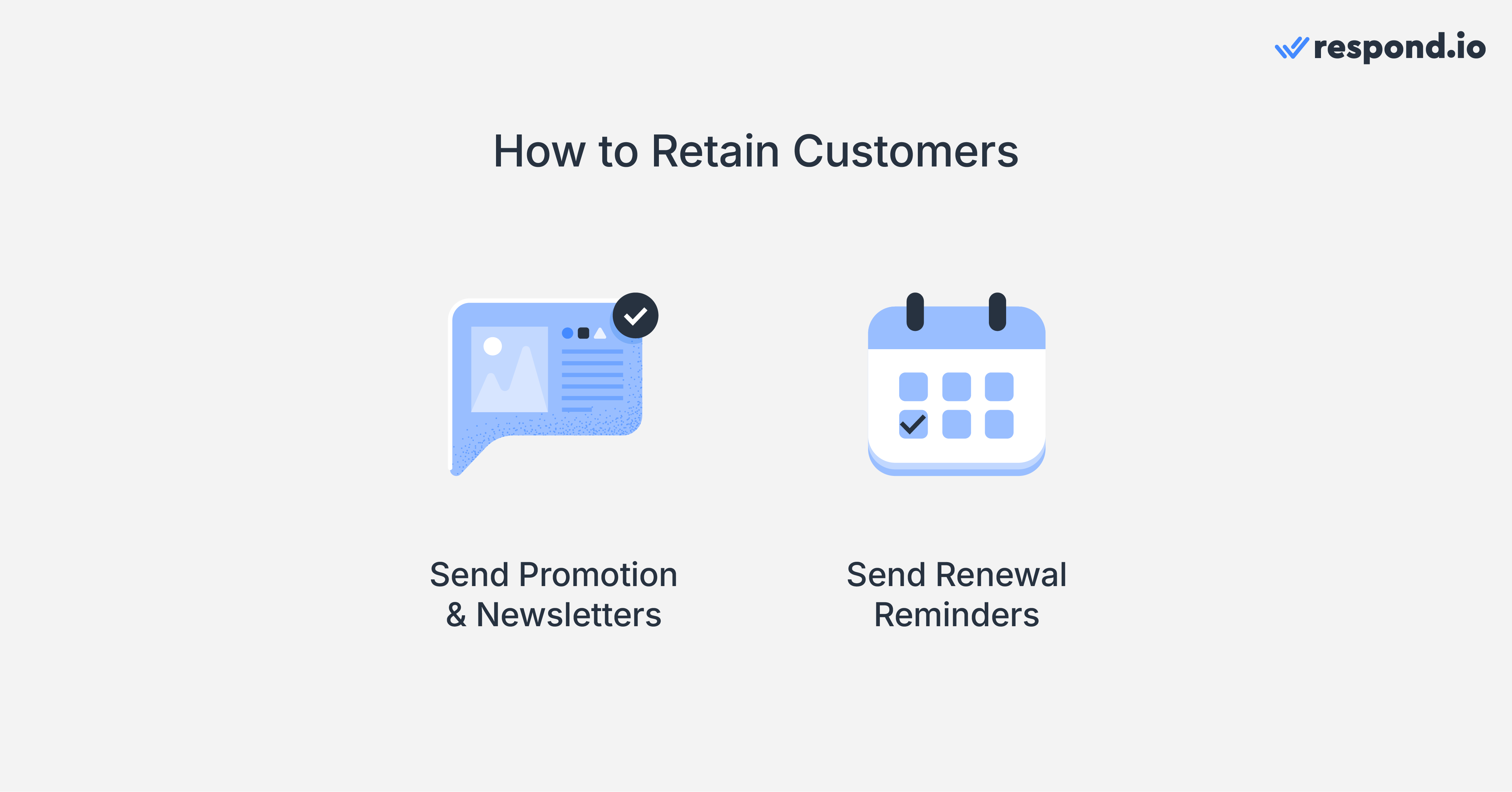
Some strategies include sending promotions and newsletters, and renewal reminders. For example, a monthly newsletter featuring personalized product recommendations and exclusive discounts can keep customers engaged and encourage repeat purchases.
Additionally, timely renewal reminders for subscription services ensure customers stay on track, reducing churn rates and reinforcing their commitment to your brand.
By implementing these strategies, businesses can foster strong relationships, drive repeat purchases, and ensure long-term growth. Next, let’s look at how respond.io can help you apply the conversation-led growth framework in your current business processes.
Conversational Growth Strategy: Managing Sales Conversations Using Conversation-Led Growth™ on Respond.io
When it comes to effective customer conversation management, respond.io emerges as a dedicated platform offering a comprehensive suite of solutions to streamline and optimize conversations. This platform brings key advantages that align with the conversation-led growth framework.
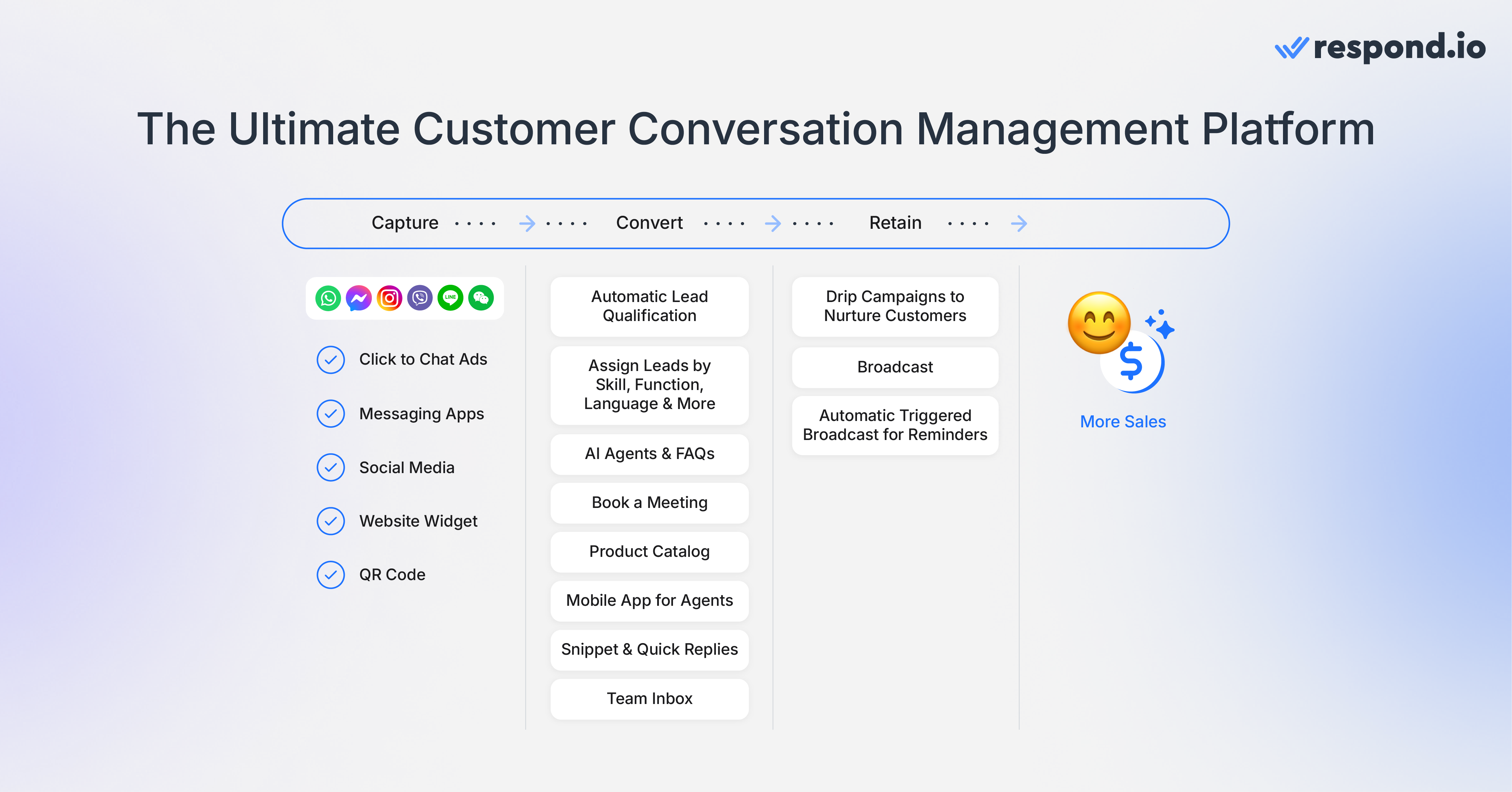
Centralized channel management: Respond.io unifies your traditional and instant messaging channels into a single platform. This ensures that your team has a unified hub to monitor and respond to inquiries across various channels, fostering consistency and efficiency in customer interactions.
Manage and track leads: With the Lifecycle Module, businesses can track and manage Contacts throughout every stage of your sales process, from the first interaction to conversion. Gain valuable insights into your sales funnel to ultimately convert more leads into customers.
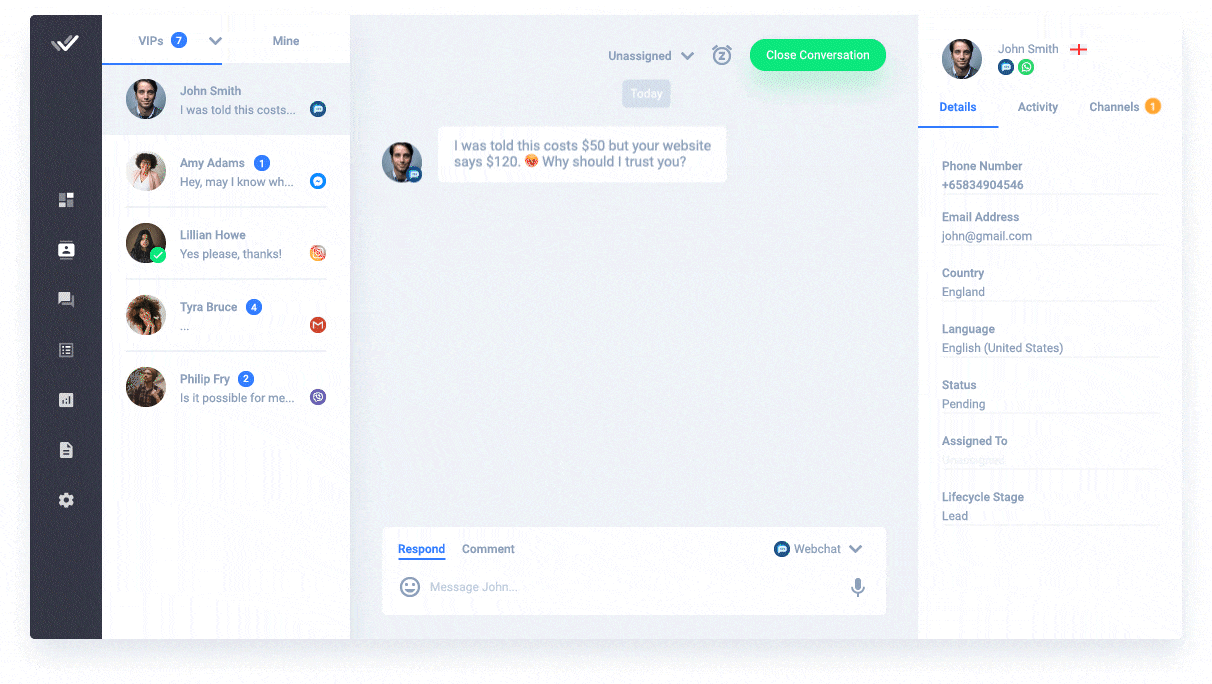
Seamless conversation capture: Respond.io offers seamless methods for capturing conversations through QR codes, chat links and click-to-chat ads. These tools effectively attract potential customers, ensuring that every conversation finds its way into a unified inbox without being missed.
Powerful automation: One of the platform's strengths lies in its capacity to automate processes, from basic tasks to complicated workflows. Respond.io's Workflows automation provides the flexibility you need to automate processes of any complexity.
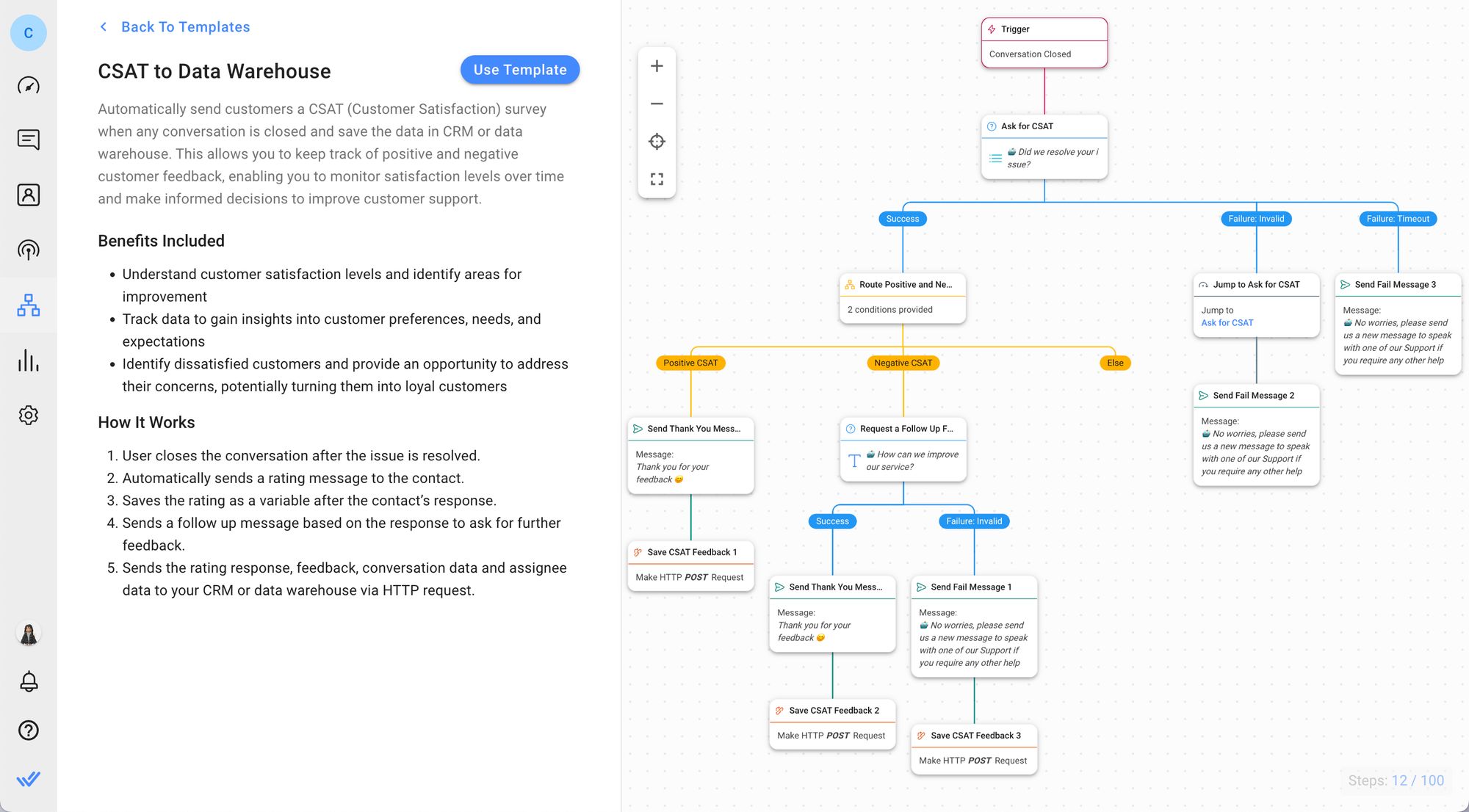
AI agents that can handle entire conversations or assist human agents: Respond.io's AI agent can answer product or service enquiries, qualify customers, send payment or appointment booking links, and route only ready buyers to your team for faster conversions and shorter sales cycles
Respond.io also harnesses AI to provide valuable assistance to human agents. With AI Prompts, agents can improve and translate messages, ensuring that every interaction is personalized, professional and polished. Additionally, AI Assist helps agents answer questions promptly by analyzing queries and providing responses based on message context.
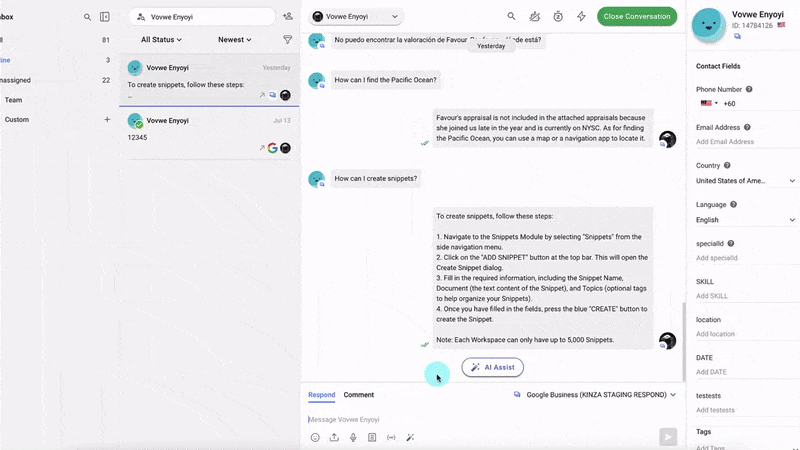
Enhanced conversations: Respond.io's features are designed to facilitate highly effective conversations. The platform provides flexible integrations to gain valuable customer context, aiding in tailored responses that ensure each interaction is meaningful and valuable.
Collaborative features further enable your team to work seamlessly, streamlining communication and providing comprehensive support.
Next, let’s look at a real-life example that depicts the power of great conversations.
How Managing Conversations Well Boosted Conversions, Revenue and Customer Loyalty for H&H Skincare
H&H Skincare, a renowned skincare retailer, gained recognition for its 24/7 customer consultation and support. However, expanding its communication channels led to a critical challenge – a customer service bottleneck.
Respond.io emerged as the solution. It unifies its communication channels and allows H&H to scale its teams easily with tools to assist in context-gathering and collaboration. Combined with powerful automation capabilities, H&H was able to respond promptly to inquiries and provide personalized responses and solutions.
The outcome was remarkable. A 300% increase in the number of customers it chatted with daily, a 160% surge in sales over just six months and a strong 60% rate of returning customers. Respond.io's partnership revolutionized H&H Skincare's customer service, boosting engagement, loyalty and tangible business growth.
Now that we’ve explored the Conversation-Led Growth™ framework, let’s put this knowledge into action. Try respond.io for free and unlock a world of efficient and customer-centric communication.
Turn customer conversations into business growth with respond.io. ✨
Manage calls, chats and emails in one place!
Frequently Asked Questions About Conversation-Led Growth™
What is Conversation-Led Growth?
Conversation-Led Growth™ (CLG) is using two-way messaging (e.g., WhatsApp, Facebook Messenger, Instagram, TikTok) to get customers in, help them buy, and keep them coming back. It replaces forms and slow email with real-time chats that drive revenue.
How does Conversation-Led Growth™ work (Capture, Convert, Retain)?
Capture: Get people to start a chat—click-to-chat ads, website chat, QR codes.
Convert: Qualify fast (ai agent intake, human takeover), share catalog/payment links, and close.
Retain: Send useful follow-ups—order updates, reorders, reminders, and exclusive offers.
Which channels should I use for Conversation-Led Growth™?
Use the apps your customers already open daily. For most B2C brands that’s WhatsApp, Facebook Messenger, Instagram and TikTok. Start with one or two, then expand.
What stages of Conversation-Led Growth™ can I automate?
Automation can be used in every stage, from optimizing your ads to capture new customers, to using AI agents to qualify leads and help book appointments and send payment details, to sending timely promotional messages or surveys to boost customer retention.
Further Reading
If you enjoyed this article, here are some more readings to help you kickstart your conversational growth strategy.






































 Electronics
Electronics Fashion & Apparel
Fashion & Apparel Furniture
Furniture Jewelry and Watches
Jewelry and Watches
 Afterschool Activities
Afterschool Activities Sport & Fitness
Sport & Fitness
 Beauty Center
Beauty Center Dental Clinic
Dental Clinic Medical Clinic
Medical Clinic
 Home Cleaning & Maid Services
Home Cleaning & Maid Services Photography & Videography
Photography & Videography
 Car Dealership
Car Dealership
 Travel Agency & Tour Operator
Travel Agency & Tour Operator




